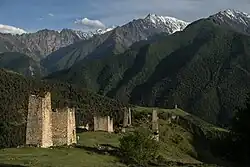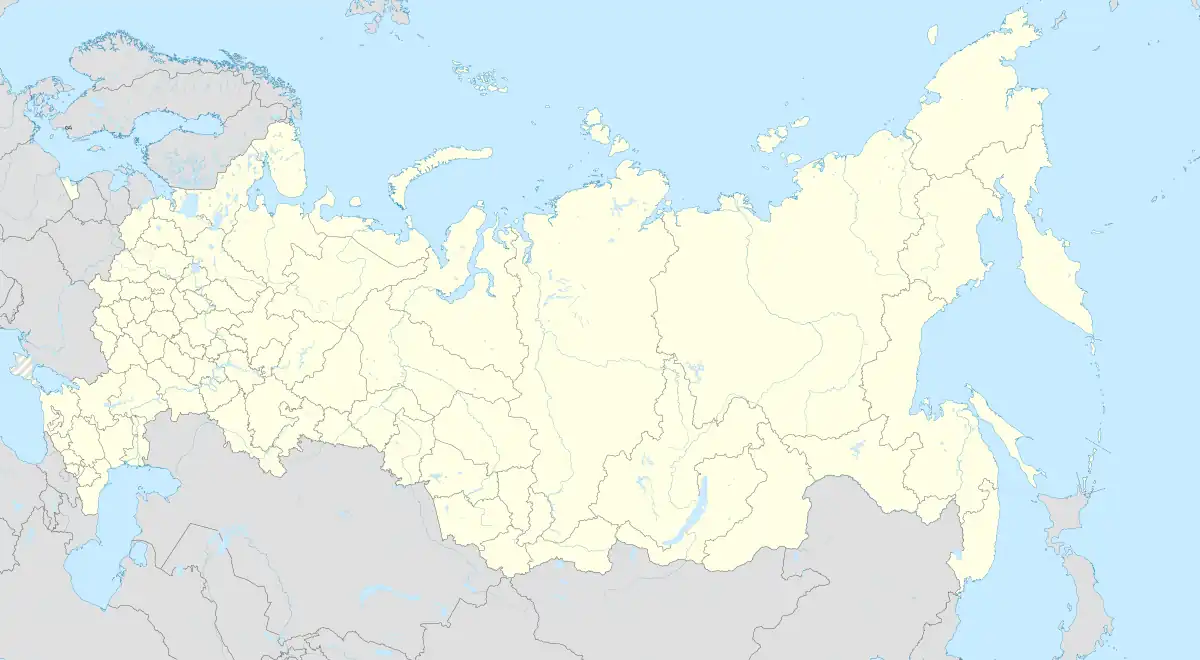Falkhan
Falkhan (Russian: Фалхан, Ingush: Фалхан) is a rural locality (a selo) in the Dzheyrakhsky District of Ingushetia, Russia. It is part of the Lyazhgi rural settlement.[4]
Falkhan
Фалхан | |
|---|---|
| Other transcription(s) | |
| • Ingush | Фалхане |
 Towers of Falkhan | |
Location of Falkhan | |
 Falkhan Location of Falkhan  Falkhan Falkhan (Republic of Ingushetia) | |
| Coordinates: 42°49′16″N 44°44′07″E | |
| Country | Russia |
| Federal subject | Ingushetia |
| Population | |
| • Total | 0 |
| • Estimate (2021)[2] | 0 |
| • Subordinated to | Dzheyrakhsky District |
| Postal code(s)[3] | 386430 |
Name
The toponym is of ancient origin. It splits into three parts: Falkha-n-e, out of which, "-n" and "-e/ye" are suffixes of Ingush language.[5] Ethnonym Falkhankhoy (a teip) takes its name from Falkhan.[6] According to Akhmad Suleymanov, the name of the village is associated with the Ingush word fala (фала) which means "free".[7]
Geography
Falkhan is located in the Kistin Gorge,[8] on the slope of the spur of the Tseylomsky Ridge, on the right bank of a small mountain stream Mekhinchie south of the villages of Metskhal and Khast-Mokie. There are nearby several pastures and meadows like Tielta, Velkh tsona, Dal-tsonashkie, Mekhanchie and others, sometimes common to all nearby auls. In addition, there are old places of worship like Myat Selash, Ashp Koag, Gerg-Argie, Motskharashkie and others.[9]
History
Early History
Together with the villages of Targim, Egikal, Khamkhi and Metskhal, Falkhan is considered one of the historical cradle of the Ingush people.[10][11] According to ethnographer Bashir Dalgat, all of the villages and settlements (more than 20) of the Fyappin Society originate from Falkhan.[12] The population village was mainly made up of the Dzarakhovs, but also Adzhievs, Bersanovs, Umarovs and Kotievs.[13]
According to a legend, the village was founded by Ferkhast and his three sons who left village of Tyarsh. The territory of the village belonged to the Ghamnäqhan tribe (Ingush: ГIамнаькъан) which made it hard for others to settle here.[14] According to the same legend, the Ghamnäqhan were later killed by the inhabitants of Falkhan.[15][14]
The village consisted of Ingush towers which possibly date back to the 16th-17th centuries: 3 battle towers, a semi-combat tower and 12 residential towers. All the towers are 5-storey with flat roofs and high parapets. Throughout history, the towers were studied by archeologists like Leonid Semyonov, Ivan Shcheblykin, Evgeny Krupnov, Aleksey Robakidze, Vladimir Markovin, Jabrail Chakhkiev.[16]
The inhabitants were engaged in the manufacture of products from horn, clay, bone, wood and archery weapons. Cloth making, deposits of sulfur and saltpeter were developed, there were ores of copper and sulfur pyrites, brown iron ore, lead and zinc, as well as ocher.[17]
Later years
In 1811–1812, there were 30 households in Falkhan.[18][13] By the 1830s, the majority of Falkhan's inhabitants migrated to the villages of Dzheyrakh-Yurt, Sholkhi, Ghalghai Yurt and Fortress of Vladikavkaz, located in plain Ingushetia.[19] By the middle of 19th century, Dzarakhovs and Kotievs of Falkhan migrated to the village of Angusht. During that time, a mosque and a madrassa was built opposite of the Solar Necropolis of Falkhan with the help of Andi theologian Murdal-Hajji. Dibr-Mulla worked as the imam of the mosque at the request of Murdal-Hajji.[17]
In 1886, there were 22 families living in Falkhan: 10 Dzarakhov families, 3 Kotiev families, 3 Bersanov families and 2 Adzhiev families.[13]
Particularly massive migrations occurred in the middle of the 20th century as a result of the Deportation of the Chechens and Ingush. The last residents left Falkhan on February 23, 1944. After returning from Deportation, the natives of the village were denied to settle back in the aul as a result of new policy of Soviet Union.[17]
Modern
Today, the village with its historical sites is included in the Dzheyrakh-Assa Museum-Reserve.[17]
Demographics
| Year | Pop. | ±% |
|---|---|---|
| 1874 | 71 | — |
| 1883 | 143 | +101.4% |
| 1890 | 115 | −19.6% |
| 1914 | 87 | −24.3% |
| 1929 | 20 | −77.0% |
Source:
| ||
Notable people
- Dzhokhar Dzarakhov, musician.[20]
- Ganyzh Keligov-Falkhanov, expert of Ingush folklore and culture, friend of Bashir Dalgat.[21]
- Magomed-Girey Dzarakhov, participant of Defense of Brest Fortress in World War Two.[22]
- Zakre Dzarakhov, participant of Defense of Brest Fortress in World War Two.[22]
References
- Russian Federal State Statistics Service (2011). Всероссийская перепись населения 2010 года. Том 1 [2010 All-Russian Population Census, vol. 1]. Всероссийская перепись населения 2010 года [2010 All-Russia Population Census] (in Russian). Federal State Statistics Service.
- Итоги Всероссийской переписи населения 2020 года. Федеральная служба государственной статистики.
- Почта России. Информационно-вычислительный центр ОАСУ РПО. (Russian Post). Поиск объектов почтовой связи (Postal Objects Search) (in Russian)
- Zakon Respubliki Ingushetia ot 23 fevralya 2009 goda.
- Kurkiev 1979, pp. 214, 225.
- Kurkiev 1979, p. 230.
- Suleymanov 1978, p. 21.
- Dzarakhova 2016, p. 22.
- Suleymanov 1978, pp. 21–22.
- Krupnov 1971, p. 49.
- Kuznetsov 2004, p. 40.
- Dalgat 2008, p. 150.
- Dzarakhova 2016, p. 24.
- Dzarakhova 2016, p. 23.
- Dakhkilgov 1978, p. 37.
- Chakhkiev 2003, pp. 36–37.
- Dzarakhova 2016, p. 28.
- Kobychev 1982, p. 29.
- Dzarakhova 2016, pp. 27–28.
- Dzarakhova 2021.
- Dzarakhova 2020.
- Kharsieva 2022.
Bibliography
- Chakhkiev, J. Yu. (2003). Aliroev, I. A. (ed.). Древности горной Ингушетии [Antiquities of mountainous Ingushetia] (in Russian). Vol. 1. Nazran: Kavkazskaya zdravnitsa. pp. 1–144.
- Dakhkilgov, I. A. (1978). "Народная этимология некоторых топонимов Чечено-Ингушетии (По легендам и преданиям)" [Folk etymology of some toponyms of Checheno-Ingushetia (According to legends and traditions)]. In Aliroev, I. Yu.; Selimov, A. A.; Shekurova, V. G.; Bibulatov, N. S. (eds.). Вопросы отраслевой лексики [Questions of industry vocabulary] (in Russian). Grozny: Chech.-Ing. kn. izd-vo. pp. 35–42.
- Dzarakhova, Z. M.-T. (2016). "О горном селении Фалхан (полевые этнографические материалы)" [About the mountain village of Falkhan (field ethnographic materials)]. Vestnik Ingushkogo nauchno-issledovatelskogo instituta gumanitarnykh nauk im. Ch. E. Akhrieva (in Russian). Magas: Ingushkiy nauchno-issledovatelsky institut gumanitarnykh nauk im. Ch. E. Akhrieva (2): 22–29.
- Dzarakhova, Z. M.-T. (2020-10-06). "Об ингушах и Ингушетии: Башир Керимович Далгат — просветитель, этнограф, антрополог, ученый, общественный деятель" [About the Ingush and Ingushetia: Bashir Kerimovich Dalgat - educator, ethnographer, anthropologist, scientist, public figure]. Ingushetia (in Russian). GAU redaktsiya gazety "Ingushetia".
- Dzarakhova, Z. M.-T. (2021-03-16). "Музыкальный фольклор ингушей: Многообразие жанров песенной культуры ингушского народа" [Musical folklore of the Ingush: The variety of genres of song culture of the Ingush people]. Ingushetia (in Russian). GAU redaktsiya gazety "Ingushetia".
- Kharsieva, L. (2022-06-21). "Трагическая и героическая дата: 81 год назад началась ВОВ: воины-ингуши на передовой" [Tragic and heroic date: 81 years ago the Second World War began: Ingush warriors on the front line]. Ingushetia (in Russian). GAU redaktsiya gazety "Ingushetia".
- Kobychev, V. P. (1982). Gardanov, V. K. (ed.). Поселения и жилище народов Северного Кавказа в XIX-XXвв. [Settlements and housing of the peoples of the North Caucasus in the 19th-20th centuries] (in Russian). Moskva: Nauka. pp. 1–191.
- Kurkiev, A. S. (1979). Основные вопросы лексикологии ингушского языка [The main questions of the lexicology of the Ingush language] (in Russian). Grozny: Chech.-Ing. kn. izd-vo. pp. 1–254.
- Kuznetsov, V. A. (2004). Kuchiev, A. G. (ed.). Введение в кавказоведение (историко-этнологические очерки народов Северного Кавказа) [Introduction to Caucasian Studies (Historical and Ethnological Essays on the Peoples of the North Caucasus)] (in Russian). Vladikavkaz: IPP im. V. A. Gassieva. pp. 1–184. ISBN 5-7534-0700-5.
- Krupnov, E. I. (1971). Средневековая Ингушетия [Medieval Ingushetia] (in Russian). Moskva: Nauka. pp. 1–211.
- Мальсагов, З. К. (1963). Оздоева, Ф. (ed.). Грамматика ингушского языка [Grammar of the Ingush language] (in Ingush and Russian). Vol. 5 (2nd ed.). Грозный: Чечено-Ингушское Книжное Издательство. pp. 1–164.
- Terskiy Oblastnoy Statisticheskiy Komitet (1885). Blagoveshchenskiy, N. A. (ed.). Список населенных мест Терской области: По сведениям к 1-му января 1883 года [List of populated areas of the Terek region: According to information on January 1st of 1883] (in Russian). Vladikavkaz: Tip. Terskogo Oblastnogo Pravleniya. pp. 1–78.
- Terskiy Oblastnoy Statisticheskiy Komitet (1890). Maksimov, E. (ed.). Сунженский отдел [Sunzhensky Otdel]. Statisticheskiy tablitsy naselennykh mest Terskoy oblasti (in Russian). Vol. 1: Issue 1. Vladikavkaz: Tip. Terskogo Oblastnogo Pravleniya. pp. 1–85.
- Terskiy Oblastnoy Statisticheskiy Komitet (1915). Gortinsky, S. P. (ed.). Список населенных местт Терской области: (По данным к 1-му июля 1914 года) [List of populated places in the Terek region: (as of July 1, 1914)] (in Russian). Vladikavkaz: Elektro-pechatnya Tip. Tersk. Obl. Pravl. pp. 2, 15–459.
- Severo-Kavkazskoe kravoe statisticheskoe upravlenie (1929). Поселенные итоги переписи 1926 года по Северо-Кавказскому краю [Settled results of the 1926 census in the North Caucasus region] (in Russian). Rostov-Na-Donu: Otdel perepisi. pp. 1–544.
- Suleymanov, A. S. (1978). Shaykhiev, A. Kh. (ed.). Топонимия Чечено-Ингушетии. Часть 2. Горная Ингушетия (юго-запад) и Чечня (центр и юго-восток) [Toponymy of Checheno-Ingushetia. Part 2. Mountainous Ingushetia (southwest) and Chechnya (center and southeast)] (in Russian). Grozny: Chech.-Ing. kn. izd-vo. pp. 1–233.
- Dalgat, B. K. (2008). Tishkov, V. A.; Kudelin, A. B.; Gatsak, V. M. (eds.). Родовой быт и обычное право чеченцев и ингушей. Исследование и материалы 1892-1894 гг. [Tribal life and customary law of the Chechens and Ingush. Research and materials of 1892-1894] (in Russian). Moskva: IMLI RAN. pp. 1–382. ISBN 978-5-9208-0307-8.
- "Закон Республики Ингушетия от 23 февраля 2009 года № 5-рз "Об установлении границ муниципальных образований Республики Ингушетия и наделении их статусом сельского, городского поселения, муниципального района и городского округа"" [Law of the Republic of Ingushetia dated February 23, 2009 No. 5–section "On establishing the boundaries of municipalities of the Republic of Ingushetia and granting them the status of rural, urban settlements, municipal districts and urban districts"]. docs.cntd.ru (in Russian). 2009. Archived from the original on 2018-01-28. Retrieved 2015-03-17.
- Zeydlits, N. (1878). Терская область. Список населенных мест по сведениям 1874 года [Terek region. List of populated places according to 1874]. Spiski naselennykh mest Kavkazskogo kraya (in Russian) (1st ed.). Tiflis: Kav. stat. kom. pri Gl. upr. namestnika Kavkazskogo. pp. 1–81.